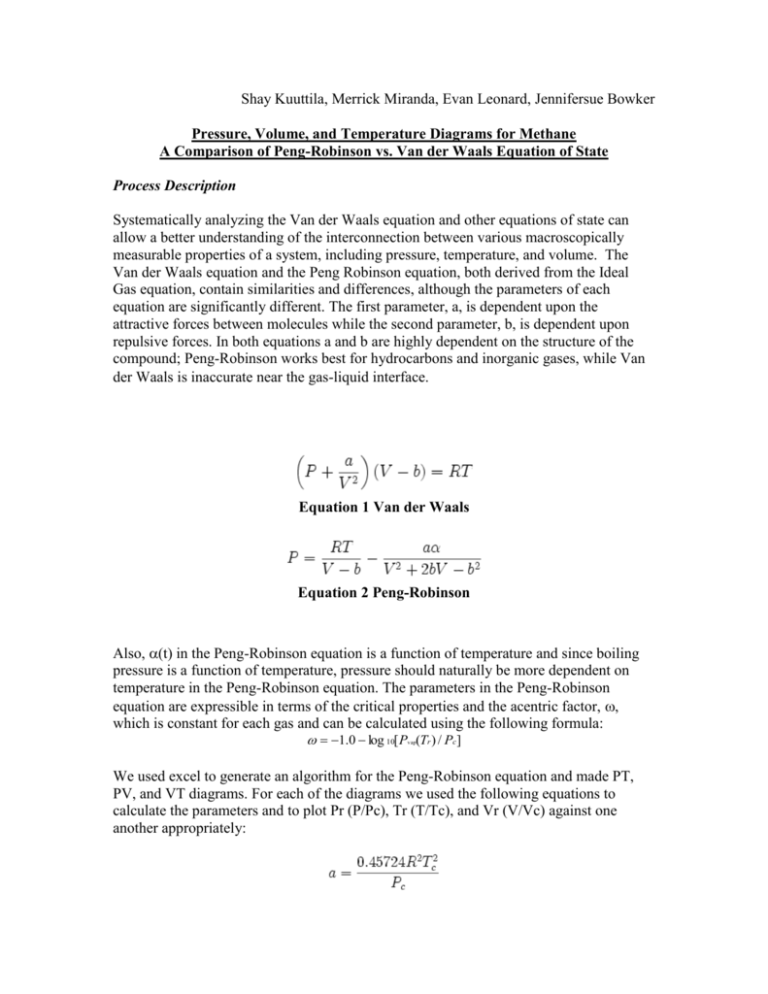PT Diagram:
advertisement

Shay Kuuttila, Merrick Miranda, Evan Leonard, Jennifersue Bowker Pressure, Volume, and Temperature Diagrams for Methane A Comparison of Peng-Robinson vs. Van der Waals Equation of State Process Description Systematically analyzing the Van der Waals equation and other equations of state can allow a better understanding of the interconnection between various macroscopically measurable properties of a system, including pressure, temperature, and volume. The Van der Waals equation and the Peng Robinson equation, both derived from the Ideal Gas equation, contain similarities and differences, although the parameters of each equation are significantly different. The first parameter, a, is dependent upon the attractive forces between molecules while the second parameter, b, is dependent upon repulsive forces. In both equations a and b are highly dependent on the structure of the compound; Peng-Robinson works best for hydrocarbons and inorganic gases, while Van der Waals is inaccurate near the gas-liquid interface. Equation 1 Van der Waals Equation 2 Peng-Robinson Also, (t) in the Peng-Robinson equation is a function of temperature and since boiling pressure is a function of temperature, pressure should naturally be more dependent on temperature in the Peng-Robinson equation. The parameters in the Peng-Robinson equation are expressible in terms of the critical properties and the acentric factor, , which is constant for each gas and can be calculated using the following formula: 1.0 log 10[ P (Tr ) / Pc] vap We used excel to generate an algorithm for the Peng-Robinson equation and made PT, PV, and VT diagrams. For each of the diagrams we used the following equations to calculate the parameters and to plot Pr (P/Pc), Tr (T/Tc), and Vr (V/Vc) against one another appropriately: For example, on the PV diagram, the user inputs a reasonable temperature, and the algorithm calculates the corresponding parameters, pressure and volume in the PengRobinson equation. Similarly the user inputs pressure and volume respectively for the other two diagrams, VT and PT. The program will also calculate and graph the corresponding Van der Waals diagram with the Peng-Robinson diagram for comparison. Analysis of PV Diagram For a constant temperature, a plot of the pressure vs. molar volume for methane will yield a decreasing function with two points at which the derivative of the functions are zero (see attached PV Graph). A positive or zero valued slope signifies the mechanically unstable state of the compound. The plot varies slightly for different temperatures. As the temperature approaches the critical temperature the functions of the two EOS’ converge. This occurs because though the Van der Waals equation does specify P as a function of T, the PengRobinson equation shows dependency of P on both T and a(T). This means that P (for PR) changes at a greater rate as T increases. This can be seen in the P vs. T graph. The shift is more dramatic for the Peng-Robinson case because the interactions between the molecules are represented more accurately in this equation, so when the temperature increases, the molecules internal energy increases (i.e. more rotational and vibrational movement) and the intermolecular interactions become less apparent. The graphs are different in value at lower volumes and approach the same curve as the volume increases. The function only changes drastically around the critical Volume. At low temperatures and volumes, Methane is a liquid, then the graph shows the gas/liquid equilibrium. As T approaches Tc, the value of a(T) approaches a, and the two equations become similar. Analysis of PT Diagram For a constant molar volume, one can see that a plot of the temperature vs. the pressure will give a linear function. As the temperature is increased, the pressure also increases for a given volume, as both the Van der Waals and Peng-Robinson equations describe. There are some differences between the two equations of state. The Peng-Robinson equation, describing the attraction between the molecules of the gas as a function of T and the molecular size, will have a steeper slope. At low temperatures, the molecular attractions are a more significant force than the temperature, but at higher temperatures, the intermolecular interactions are less important as the molecular movements are greatly increased. The Van der Waals equation simply relates an attractive force to the molar volume and is much more generalized and so does not recognize the diminished intermolecular attractions a small molecule such as methane has. Clearly, the Peng-Robinson is a more suitable equation for methane. Analysis of VT Diagram For a constant pressure, a plot of the molar volume vs. temperature yields an increasing function. The slope before the critical temperature is very small where methane exists in liquid/vapor equilibrium, but above the critical temperature, where all of the liquid is transformed into vapor, the slope is much greater. Near the critical temperature, both graphs show a very steep increase in the molar volume for small changes in temperature. This represents the decreasing interactions between molecules as the substance turns from liquid to gas. The Van der Waals equation, poorly relating the attractive forces, gives a higher volume for a given temperature and pressure. The disparity between the two EOS’ decreases for higher temperatures as once again a(T) approaches a. Conclusion Also, at higher T and V’s, above the critical point, the substance is in a gas phase and intermolecular attractions are not as strong as they are when the substance is in a liquid/vapor equilibrium, and so the Peng-Robinson EOS is very similar to Van der Waals. The Peng-Robinson model more accurately shows the relationship of state parameters as it expresses the attractive forces as both a function of T and molecular size.








